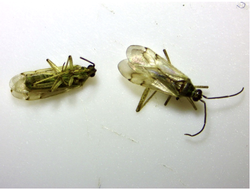The Latest Dirt - Sept 2023
Bug ID: It Takes a Team
By Sheila Weston

He said these have been around his plants for the last three years. The plants have grown well and have flowered but failed to set much fruit. He has seen small bugs on the leaves that look like 'fast-moving aphids,' which he thinks are the 'nymphs' of this fly and are causing the lack of fruit.
The plants have grown well this year, and he has not seen so many 'nymphs.' He thinks the recent rains slowed them down. The tomatoes are watered deeply once a week. And while he had not mulched in previous years, he added wood chip mulch this year. There is full sun most of the day.
Volunteers at the table that day, Sheila Weston, Stephanie Hargrave, and Stephen Guglielmana, told him they had not heard of flies causing this problem. The 'aphid-like nymphs' he has seen are probably unrelated, as fly larvae are grubs rather than nymphs. We told him we would work on identifying the insect and asked him to report back if the lack of fruit persists this year. We also asked for more information on the 'nymphs' seen on the leaves.
Sheila froze and then refrigerated the specimens, examining them with a hand lens and a rather useless old microscope! One pair of wings looked like a fly, possibly a fungus gnat, but the resolution was not good. She could not get good photos, so she took the specimens to Susan Heckly, who tried to get better pictures but failed.
A trip to the still-closed Help Desk office to use the digital microscope gave us a better image that was sent to Terri Takusagawa.
Terri responded, "Thank you! The pics really help, especially the view of the underside: four wings and the long sucking mouthpart. The client said the young looked like flying adults but without wings (incomplete metamorphosis). So, it's not a fly. I found a pretty good match on Bug Guide (https://bugguide.net/node/view/15740). It is a tomato bug (Engytatus modestus), a true bug in the family Miridae (plant bugs).
Sheila Weston's final response to the client:
Thank you for coming into Our Garden again today. I'm so glad we managed to identify your tomato pest. Your persistence did pay off for all of us. I, for one, had not heard of this bug, and I have learned something!
Here is the promised information about the tomato bug, Engytatus modestus. These photos are from the website that we discussed, bugguide.net.
https://bugguide.net/node/view/1901196/bgimage
https://bugguide.net/node/view/482970/bgimage
I found some information from UC about the tomato bug, written for Agriculture and not home gardeners. They have yet to research how to deal with this specific insect. They mention that management tactics for the related insects, stink bugs, and lygus bugs may be effective for this one. Tacticsis involves controlling nearby broadleaf weeds, which may give the bugs an alternate home, and handpicking them off your plants. (Nymphs may be easier than adults—not so easy for these tiny insects!) You can try knocking them off into a container of soapy water, but don't spray soap on the plant! Insecticides are not advised.
You can find out more about managing stink bugs and lygus bugs by clicking the relevant links in the UC Tomato Pest Note:
https://ipm.ucanr.edu/home-and-landscape/tomato/index.html.
I hope this helps. Thank you for your continued support of the UC Master Gardener Program!
